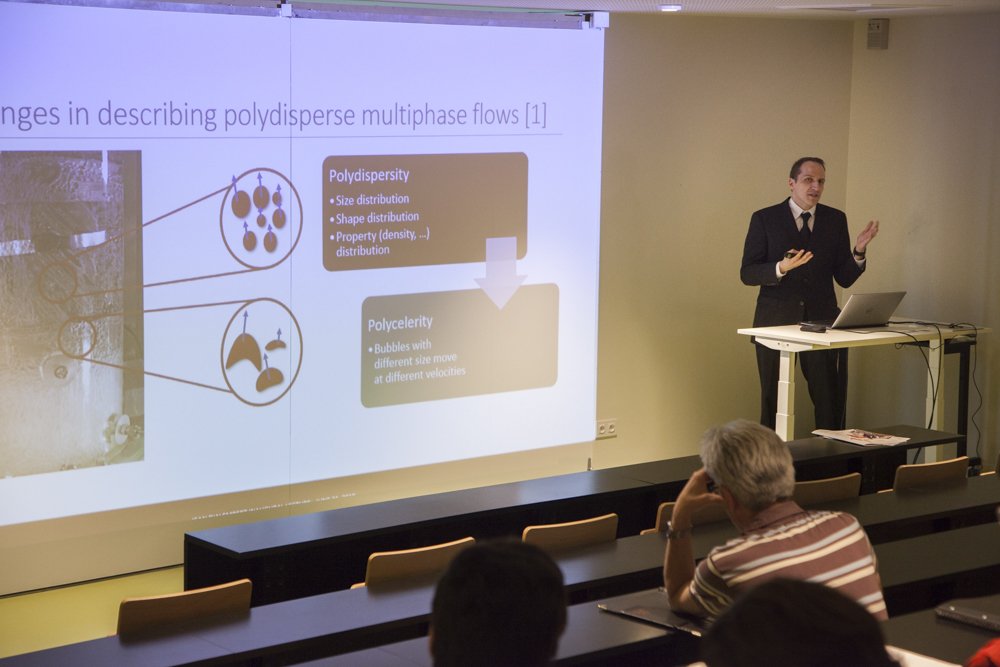
One mechanical engineering professor is advancing his research by studying halfway across the globe.
Alberto Passalacqua, an associate professor of mechanical engineering with a courtesy appointment in chemical and biological engineering, is conducting research that can be used to better understand the effect that tiny particles (<10 micrometers) produced by car emissions, known as soot, can have on our lungs. Passalacqua and his team are developing mathematical formulas to study this.
Passalacqua has spent his summer in the Macroscopic Molecular Energy and Combustion Laboratory (EM2C) at CentraleSupélec – Université Paris-Saclay in Paris, France, advancing this research. His travel is supported by the Jean d’Alembert fellowship program for junior researchers, which also provided funds for him to spend three months in EM2C during summer 2017. While at CentraleSupélec, Passalacqua has had the opportunity to work with Dr. Frédérique Laurent-Nègre on the modeling of polydisperse multiphase flows.
As part of his work in the lab, Passalacqua recently gave a lecture at CentraleSupélec entitled “How to describe polydisperse multiphase flows.”
“The lecture aimed at introducing what polydisperse multiphase flows are and what are the challenges of describing them using computer simulation tools to a broad audience,” said Passalacqua. “The name of these flows may seem a bit obscure, but we see them around us every day when we spray something, we produce them when we drive and pollute, they form in the clouds when volcanoes erupt, and in several industrial applications from drug production to food industry.”
He said that describing the behavior of flows that contain particles, droplets or bubbles can be difficult because of the number of phenomena that can happen simultaneously. These flows also exhibit different affects when they interact with one another.
“For example, bubbles in a liquid move but break, and breaking they change velocity. Heavy particles in air tend to congregate forming regions at higher concentrations, depending on the air motion,” said Passalacqua. “Being able to include all these physical phenomena in a model – think of it as a complex set of equations – is difficult, and it is only the first step. Once the equations are formulated, they need to be accurately solved, and as fast as possible to be useful for practical applications such as engineering design and environmental predictions.”
Much of this research is multidisciplinary as it combines elements of mechanical engineering along with physics, mathematics and computer science to create software that can accurately recreate flows and other related phenomena.
“In my group we are contributing our developments to the community by means of our open-source framework OpenQBMM, so that others can benefit from our results,” Passalacqua said.
During his lecture Passalacqua also discussed his research at EM2C which involves two aspects of quadrature-based moment methods. The first aspect concerns the accuracy of the mathematical methods used to solve models for polydisperse multiphase flows, while the second focuses on the formulation of a specific model for gas-liquid systems.
“Collaborating with the researchers at EM2C has been essential to address some of the mathematical challenges we faced when using moment methods. The mathematical background of the researchers and their long-term expertise in these methods is unique. Interacting with them and learning how they tackle problems from a different perspective was extremely beneficial,” said Passalacqua. “More broadly, spending time in a different research system, which is organized, managed and funded in a quite different way than the one I am used to is very interesting and shows areas where our system may be improved.”
Despite spending much of his summer in the lab, Passalacqua has been able to enjoy the sights and sounds of the City of Light.
“It is impressive to see how active, chaotic and at the same time livable Paris is. I love art, so I spend most of my spare time visiting the historical parts of the city. At every corner there is something to see, and there are a lot of little restaurants to explore,” he said.
Once he returns to Ames in August, Passalacqua – who also serves as a Team Leader at Iowa State’s Center for Multiphase Flow Research and Education – will continue work on a research project funded by the U.S. Department of Energy’s Advanced Manufacturing Office. This project aims to develop an open-source framework for the design and scale-up of autothermal biomass pyrolizers used to produce bio-oil.
Passalaqua is also collaborating with the University of Ottawa on a separate multiphase flow modeling project which aims to model electrostatics in fluidized bed reactors and this fall plans to host a visiting scholar from the Ottawa institute.
“I look forward to bringing back the experience I gained during my stay in France to my group and my department,” he said.